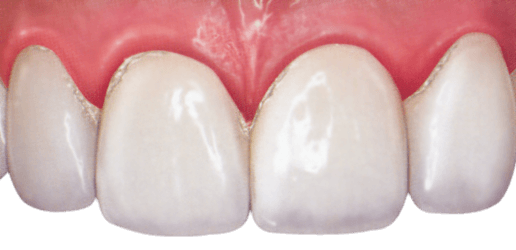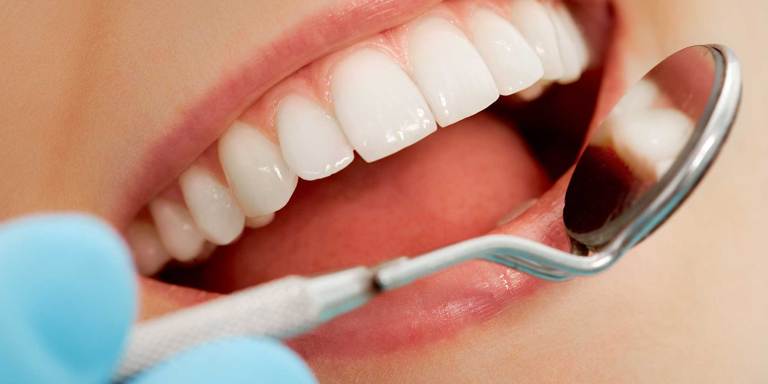Preventive Dentistry
Regular maintenance provides the routine oral health care you need to keep your teeth bright and strong.Brushing
Step 1 - Place bristles along the gum line at a 45 degree angle. Gently brush using a circular motion along the outer and inner tooth surfaces.
Step 2 - Brush each tooth individually. Tilt brush vertically behind the front teeth. Using the front half of the brush, use the same circular motion.
Step 3 - Place the brush against the biting surface of the teeth and use a gentle back-and-forth motion. Brush the tongue to remove odor-producing bacteria.
Flossing
Flossing removes bits of food and any plaque build-up that is caught or stuck in the tight spaces between teeth and just below the gumline where a toothbrush cannot easily reach. Proper daily flossing combined with regular brushing is one of the easiest things you can do to prevent cavities and gum disease.
Floss is cheap, so don't be stingy. Wind about 18 inches of floss evenly around each of your middle fingers until one to two inches of floss is left between the two finders. Using your thumbs and index fingers, firmly grip the floss and slide the floss between your teeth. Curve the floss around the base of your tooth while using a gentle up-and-down motion, remove food particles and any plaque build-up between the two teeth. Take special note to make sure the floss reaches just below the gumline to ensure proper and thorough cleaning.
Repeat this step for all of your teeth and unwind a clean section of floss between your fingers as you move between teeth.
NEVER "saw" at your gums with dental floss or force the floss between teeth as this can damage gum tissue and be extremely painful.
Fluoride
Fluoride, a substance that's found naturally in water, plays an important role in healthy tooth development and cavity prevention.
Fluoride combats tooth decay in two ways:
- It strengthens tooth enamel, a hard and shiny substance that protects the teeth, so that it can better resist the acid formed by plaque.
- Fluoride allows teeth damaged by acid to repair, or re-mineralize, themselves.
Fluoride cannot repair cavities, but it can reverse low levels of tooth decay and thus prevent new cavities from forming.
The American Academy of Pediatrics recommends that these fluoride supplements be given daily to children between the ages of 6 months and 16 years. The dosage will change as your child grows. Only children living in non-fluoridated areas or children who drink only non-fluoridated bottled water should receive supplements.
Most children get the right amount of fluoride through a combination of fluoridated toothpaste and fluoridated water or supplements. Too much fluoride before 8 years of age can cause enamel fluorosis, a discoloration or mottling of the permanent teeth. This condition is unsightly but harmless and often can be treated with cosmetic procedures.

Removing Plaque & Tartar With A Teeth Cleaning
During your cleaning, we will:
- Remove plaque and tartar buildup from the surfaces of your teeth. Plaque is caused by the collection of bacteria on the teeth from food. When plaque is allowed to harden, it forms tartar which is tough and colorless and requires tooth scaling to remove.
- Polish your teeth to remove surface stains and smooth the surfaces of the teeth which makes it more difficult for plaque and tartar to build-up.
- Evaluate the severity of any signs of gum disease or past periodontal treatments which may require a deep cleaning.
Carquinez Dental Group will review your dental history to identify any potential issues that require special treatment.
Plaque
Plaque is essentially the start of gum disease problems. Plaque is a build-up from bacteria in the mouth and particles from the foods you eat every day.
Once sugars are introduced to plaque, it turns into a tooth eating acid that sits just above the gum line. If regular oral care isn't standard, the acid will start eating at the teeth producing cavities and the plaque can cause gum disease.
Plaque that is allowed to sit for a prolonged period of time can cause cavities, gingivitis, and other problems in your mouth. If it's left longer than that, serious dental procedures may be required to restore your decaying smile.

What is Tooth Scaling?
Tartar is plaque that has had time to harden and is that white (sometimes yellow) substance found at the base of the tooth just above the gumline. Tartar is usually not removed with standard brushing and flossing and usually requires coming in to see us for proper and thorough removal.
Tooth scaling is a service that involves using a tool that is specifically designed to break-apart and remove tartar. We gently run the tooth scaling tool along the front and back surfaces of teeth that have any signs of tartar which effectively cleans the gumline and smooths the tooth enamel. Every time you come in for a dental checkup, tooth scaling is performed to help prevent future dental problems such as cavities and gum disease.
What's Involved With A Root Planing Procedure?
Each person's oral health is unique and the stage and current condition of the teeth and gums will dictate how involved a deep cleaning is as well as how long it takes to heal. Usually a deep cleaning is done one-half of the mouth at a time and healing takes about a day or two.
During a deep cleaning we will numb the areas of your gums where we are working, which will keep you from feeling any discomfort during the procedure. Using a special tool, we will remove any tartar build up that is found on tooth roots below the gumline and we ensure the tooth root gets a smooth finish to allow the gum tissues to start re-attaching itself. Our office uses a special ultrasonic tool that will ensure the quickest and most comfortable deep cleaning as possible and is something some other dental offices do not offer. After your root planing procedure, you may be recommended to take a medication to help control soreness from the procedure, keep away infections and to promote healing.
Oral Cancer Screening
During every dental checkup, we will visually check and feel around for any signs of oral cancer. We check for signs of visible lesions inside the mouth and gently feel around the jaw for any lumps or swelling that may be present. Many early signs of oral cancer can go unnoticed by people as they go about their daily lives but we want to make sure that your overall oral health is in as best condition as possible when you see us for a dental checkup.
